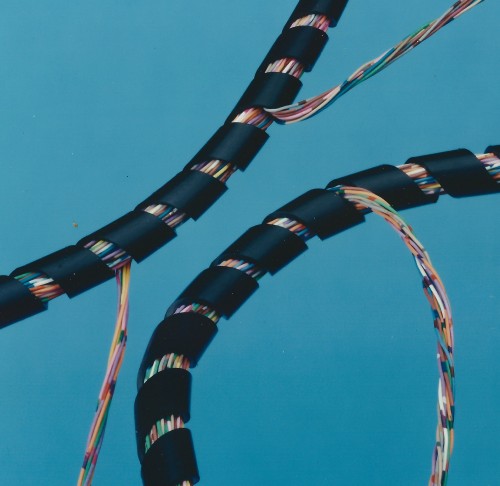
Considering protecting or organizing your wires or cables and wondering how should spiral wrap be applied? It’s a good question.
Heli-Tube® Spiral Cable Wrap is ideal for organizing wires, cables, and hoses into a bundle and is easily applied. The RoHS-compliant spirally cut cable wrap offers a substantial degree of flexibility and versatility for protecting and bundling wires and cables. It also offers resistance from abrasion and is excellent for re-routing or replacement of wires at any point in the bundle.
Unlike expandable sleeves or wire loom, spiral cable wrap allows for the breakout of single or multiple wires in any direction from the bundle with ease. Various materials are available to meet the different environmental conditions such as exposure to UV sunlight, flames, or high temperatures.
Why Should Spiral Wrap Be Applied?
Wire management is one of the more common dilemmas in the modern electronic age. Whether in the workplace or home, a twisted, tangled, kinked and knotted pile of colorful wires is a hazard, a distraction, a nuisance, and an accident waiting to happen.
For easier application, Heli-Tube® Spiral Cable Wrap is offered in two cuts. Our standard cut is what we refer to as “forward cut.” A forward cut spiral is in a clockwise direction, also referred to as a ‘right cut’ spiral wrap. The reverse cut is cut in a counter-clockwise direction. It too may be referred to as a ‘left cut’ spiral wrap.
Is It Hard to Install?
Installation is easy, takes very little preparation, and the spiral cable wrap does not require tools. In many ways, applying Heli-Tube® spiral wrap is very similar to wrapping tape around your wires. Unlike tape, spiral wrap tubing can be easily removed and reused. Don’t forget—when applying the wrap around cables and wires you can drop single wires or sets of wires out the bundle in any direction (and wrap those, too!).
How to Select the Right Spiral Wrap Material
In preparation of applying Heli-Tube® to the application, it is necessary to know the pitch, diameter, wall thickness, color, length, and so on, that is needed and desired to wrap the components. Choose the material needed for the application. The primary synthetic polymers for spiral cable wrap are Polyethylene, Fire-Resistant Polyethylene, Nylon or PTFE. Material choice is determined by application requirements, indoor or outdoor, and the type of application such as electronics and electrical control systems, electronic assemblies, computer networking systems, public utilities, automated industrial systems, robotics, hydraulics, automotive, and aeronautical among many others.
How Should Spiral Wrap Be Applied?
With the above in mind, here’s how to apply spirally cut wrap to individual applications:
1. Organize. Gather, organize and layout the wires or cables together to form into a bundle
2. Size and Wrap. Size the spiral wrap by determining the outside diameter of the bundle – you want the spiral wrap to be smaller than your bundle or it will slip. Then wrap! Start at one end of the bundle and begin to apply Heli-Tube® spirally cut wrap. Extend the tubing and begin to twist the tube wrap around the wires by gradually moving them through the tubing. As you wrap the Heli-Tube® it will spiral around the components. Continue to wrap spirally around the length of the bundle until completed.
Heli-Tube® Spiral Cable Wrap is expandable and pliable and will compact around the components snugly. If maintenance is required or additional wires or cables are needed, the wrap can be removed easily and the bundle can be rewrapped. How you position the wrap around your cables will control the flexibility of the bundle. For example, by increasing the width of the gap you can more easily bend in or around sharp corners. Closing the gap tighter means less mobility, more rigidity and greater abrasion resistance.
Have additional questions about spiral wrap? Contact us at M.M. Newman Corporation today!

